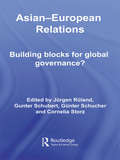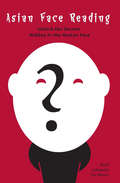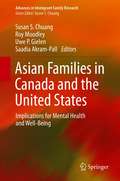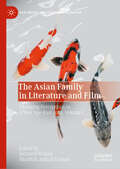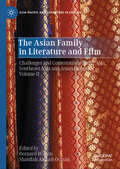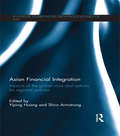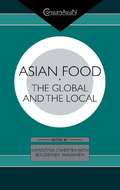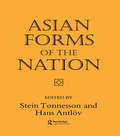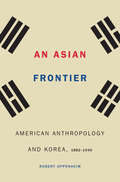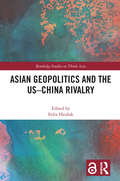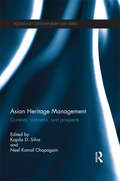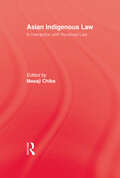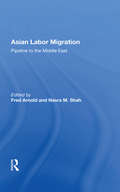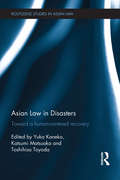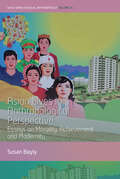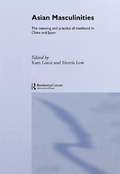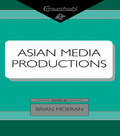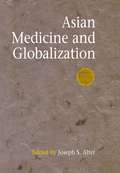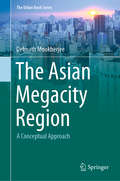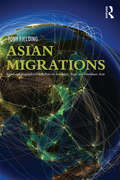- Table View
- List View
Asian-European Relations: Building Blocks for Global Governance? (Routledge Contemporary Asia Series #4)
by Jürgen Rüland Gunter Schubert Günter Schucher Cornelia StorzInterregional Relations are a novel field within international relations which have increasingly been attracting scholarly interest. Thus, over the last five years or so, Interregional Relations has firmly established itself as a research field, initially within political science, and gradually in economics. This volume assesses interregional relations between Asia and Europe. It contributes to the most recent developments in research by providing impressively rich studies to test existing theoretical frameworks. Featured in this volume are conceptual contributions, in particular, theoretically inspired studies which conduct in-depth investigation of a broad variety of interregional interactions, such as the political management of globalisation through interregional co-operation, regional security, human rights and finally, the dialogue between Asian and European NGOs. The economic contributions likewise undertake an extensive assessment of areas such as interregional trade and investment flows, the Asian Development Bank and interregional mergers. Applying established theories to concrete phenomena, Asian-European Relations provides a comprehensive understanding of inter-regionalism and how co-operation between Asia and Europe should be fashioned in the new millennium. The integration of political and economic research in this book will be of interest to graduates and researchers in the fields of international relations, international economics, regional integration, and interregionalism.
Asian Expansions: The Historical Experiences of Polity Expansion in Asia (Routledge Studies in the Early History of Asia)
by Geoff WadeAsia as we know it today is the product of a wide range of polity expansions over time. Recognising the territorial expansions of Asian polities large and small through the last several millennia helps rectify the fallacy, long-held and deeply entrenched, that Asian polities have been interested only in the control of populations, not in expanding their command of territory. In countering this misapprehension, this book suggests that Asian polities have indeed been concerned with territorial control and expansion over time, whether for political or strategic advantage, trade purposes, defence needs, agricultural expansion or increased income through taxation. The book explores the historical experiences of a set of polity expansions within Asia, specifically in East and Southeast Asia, and, by examining the motivations, mechanisms, processes, validations and limitations of these Asian territorial expansions, reveals the diverse avenues by which Asian polities have grown. The chapters draw on these historical examples to highlight the connections between Asian polity expansion and centralised political structures, and this aids in a broader and more comprehensive understanding of Asian political practice, both past and present. Through these chapter studies and the integrative introduction, the book interrogates key concepts such as imperialism and colonialism, and the applicability and relevance of such terminology in Asian contexts, both historical and contemporary. Comparisons and contrasts with European historical expansions are also suggested. This book will be welcomed by students and scholars of Asian history, as well as by those with an interest in Asian interactions, international relations, polity expansion, Asia--Europe historical comparisons and globalisation.
Asian Face Reading
by Boye Lafayette De MenteImagine how much you could learn if you knew how to evaluate a person's character, health, fortune, social status, sexual charisma, and life expectancy from a careful reading of his or her face. <P><P> In China and Japan, face reading is a respectable analytical tool used to make business decisions, arrange marriages, and evaluate partnerships and friendships. Asian Face Reading offers a quick, practical, easy-to-understand and easy-to-apply introduction to the basic principles of face reading. The book is fully illustrated with dozens of examples readers can use to learn this increasingly popular practice-and to analyze their friends, colleagues, and loved ones.
Asian Families in Canada and the United States: Implications for Mental Health and Well-Being (Advances in Immigrant Family Research)
by Susan S. Chuang Roy Moodley Uwe P. Gielen Saadia Akram-PallThis book presents a comprehensive overview of Asian families residing in Canada and the United States by portraying and analyzing Asian Canadian and Asian American immigrant families in an integrated yet nuanced way. Chapters use an interdisciplinary approach to provide more comprehensive coverage of the vast diversity as well as common trends and shared characteristics of Asian families. Specifically, the volume examines the experiences of families whose ancestry can be traced to East Asia, Southeast Asia, South Asia, and West Asia. Key areas of coverage include: Integrated overview of Asian American and Asian Canadian families, including an exploration of the historical and current immigration policies.Experiences of families of East Asian, Southeast Asian, South Asian, and West Asian ancestry across Canada and the United States.Asian religious traditions and worldviews, traditional practices, and religio-cultural views on gender, sexuality, and family.Specific Asian immigrant groups on immigration demographics, family dynamics and relationships, gendered roles, parenting practices and beliefs, and implications for mental health.Challenges and issues that families face as Asians and immigrants, the strength and resilience of families, with extensive reviews on various intervention and prevention programs.Methodological strategies in investigating Asian families and their impact on the field. Asian Families in Canada and the United States is a must-have resource for researchers, professors, graduate students as well as clinicians, professionals, and policymakers in the fields of developmental, social, and cross-cultural psychology, parenting and family studies, social work, and all interrelated disciplines.
The Asian Family in Literature and Film: Changing Perceptions in a New Age-East Asia, Volume I (Asia-Pacific and Literature in English)
by Bernard Wilson Sharifah Aishah OsmanThis book offers a key analysis of the changing perceptions of family in East Asian societies and the dynamic metamorphosis of “traditional” family units through the twentieth century and into the new millennium. The book focuses on investigations of the Asian family as it is represented in literature, film, and other visual media emerging from within China, Japan, South Korea, and Taiwan, and on contestations of the power hegemonies and moral codes that underpin such representations, while also assessing Western and global influences on the Asian family. Individually and collectively, these essays examine traditions and transformations in the evolving conception of family itself and bring together a range of scholars from within and beyond the region to reflect upon the social and cultural mores represented in these texts, the issues that concern Asian families, and projections for future families in their own societies and in a globalized world. Through the written text and the lens of the camera, what directions has the understanding of family in an Asian context taken in the twenty-first century? How have the multiple platforms of media represented, encouraged, or resisted transitions during this time? Amid broader and mutating referential frameworks and cross-cultural influences, is the traditional concept of the “nuclear family” still relevant in the twenty-first century? This book lends further prominence to the diverse literary and cinematic production within East Asia and the eclectic range of media used to represent these ideas. It will be essential reading for scholars of literature, film studies, and Asian studies, and for those with an interest in the cultural and sociological implications of the changing definitions and parameters of the family unit.
The Asian Family in Literature and Film: Challenges and Contestations-South Asia, Southeast Asia and Asian Diaspora, Volume II (Asia-Pacific and Literature in English)
by Bernard Wilson Sharifah Aishah OsmanThis book investigates the ways in which the family unit is now perceived in South and Southeast Asia and the Asian diaspora: its numerous conceptions and the changes it has undergone over the last century and into the new one. The prevailing threads that run through a significant part of the literature and cinema emerging from these societies are the challenges that confront those negotiating changing forms of family, changes which are expressed historically, politically, and socio-culturally, and often in relation to gender, ethnic, or economic imbalances. Though regional and localized in many ways, they are also very much universal in the questions they ask, the lessons they teach, and the connections they make. Theoretically, and in terms of focus, the collection offers a broad range, embracing representation and analysis from scholars across the globe and across disciplines. It assembles written and visual texts from and about India, Indonesia, Malaysia, The Philippines, Singapore, and the Asian diaspora. How have more fluid concepts of family in the late twentieth and early twenty-first centuries affected the understanding of family in Asia? How have families in Asia resisted or embraced change? How have they responded to trauma? What do other readings—gendered, feminist, queer, and diasporic—bring to modern debates surrounding family? To what extent are notions of family, community, society, and nation represented as interchangeable concepts in Asian societies? This book questions the power dynamics, ethical considerations, and moral imperatives that underpin families and societies within, and beyond, Asian borders.
Asian Financial Integration: Impacts of the Global Crisis and Options for Regional Policies (Routledge Studies in the Growth Economies of Asia)
by Yiping Huang Shiro ArmstrongIn the wake of the global financial crisis, Asia is leading the global recovery with strong economic growth. However, this book argues that, in the coming years, the region will need to play a much more active role in shaping the future global financial system and, in turn, suggests policy strategies for doing so. Asian Financial Integration explores the lessons we can learn from Asia’s experience during the global financial crisis in terms of the future direction of the region’s economic policy and the challenges posed by the opening and deepening of its financial markets. The contributors deal with a number of crucial questions, including what Asia should learn from the crisis, especially with regards to financial innovation and regulation; whether global imbalances are a result of policy distortions or a natural outcome of global division of labour; what are the lessons and implications from the financial market reform and liberalization experiences of some of the region’s major economies; and what should Asia do to promote regional financial integration, particularly with regards to currency integration. This book will be welcomed by students and scholars interested in Asian economics and international economics, as well as by policy-makers working in the field.
Asian Food: The Global and the Local (ConsumAsian Series)
by Katarzyna J. Cwiertka Boudewijn C. WalravenBy documenting, analysing and interpreting the transformations in the local diets of Asian peoples within the last hundred years, this volume pinpoints the consequences of the tension between homogenisation and cultural heterogenisation, which is so characteristic for today's global interaction.
Asian Forms of the Nation
by Stein Tønnesson Hans AntlövThe general tendency among theorists in nationalism and national identity has been to assume that the modernization process in Asia and Africa is a kind of distorted reflection of a Western precedent; Asian forms of the nation have rarely been seen as independent, alternative models. Among today's leading theoreticians, there is a growing tendency to take Asia seriously, and to include Asian examples in the general discussion. The aim of the present collection is to build on and reinforce this tendency. It does not postulate any specifically Asian form of the nation, as opposed to a Western one. Rather, it seeks to demonstrate that in Asia, as well as in Europe, each nation forms a unique amalgam which can be compared fruitfully with others. History, culture and geography have posed various kinds of limits to what can be imagined (as Benedict Anderson puts it). The relationship between geographical space and national construction is explored in depth here.
An Asian Frontier: American Anthropology and Korea, 1882–1945 (Critical Studies in the History of Anthropology)
by Robert OppenheimIn the nineteenth century the predominant focus of American anthropology centered on the native peoples of North America, and most anthropologists would argue that Korea during this period was hardly a cultural area of great anthropological interest. However, this perspective underestimates Korea as a significant object of concern for American anthropology during the period from 1882 to 1945—otherwise a turbulent, transitional period in Korea’s history. An Asian Frontier focuses on the dialogue between the American anthropological tradition and Korea, from Korea’s first treaty with the United States to the end of World War II, with the goal of rereading anthropology’s history and theoretical development through its Pacific frontier. Drawing on notebooks and personal correspondence as well as the publications of anthropologists of the day, Robert Oppenheim shows how and why Korea became an important object of study—with, for instance, more published about Korea in the pages of American Anthropologist before 1900 than would be seen for decades after. Oppenheim chronicles the actions of American collectors, Korean mediators, and metropolitan curators who first created Korean anthropological exhibitions for the public. He moves on to examine anthropologists—such as Aleš Hrdlicka, Walter Hough, Stewart Culin, Frederick Starr, and Frank Hamilton Cushing—who fit Korea into frameworks of evolution, culture, and race even as they engaged questions of imperialism that were raised by Japan’s colonization of the country. In tracing the development of American anthropology’s understanding of Korea, Oppenheim discloses the legacy present in our ongoing understanding of Korea and of anthropology’s past.
Asian Geopolitics and the US–China Rivalry (Routledge Studies on Think Asia)
by Felix HeidukThis book analyses the ways in which foreign policy actors in Asia have responded to the emerging great power conflict between the US and the People's Republic of China focusing on medium and small states across the Indo-Pacific. The book offers a much-needed counterpoint to existing analyses on the Indo-Pacific and China’s BRI and presents a new perspective by examining how great power politics are locally reinterpreted, conditioned, or at times even contested. It illustrates the policy-level challenges which the US-China rivalry poses for established political and economic practices and outlines how these challenges can be best addressed by smaller states and their societies. A timely assessment of the power play in the Indo-Pacific with the angle of Sino-American rivalry, this book makes an important contribution to the study of Political Science, International Relations, Asian Studies and Security Studies. Chapter 10 of this book is freely available as a downloadable Open Access PDF at http://www.taylorfrancis.com under a Creative Commons Attribution-Non Commercial-No Derivatives (CC-BY-NC-ND) 4.0 license.
Asian Heritage Management: Contexts, Concerns, and Prospects (Routledge Contemporary Asia Series)
by Kapila D. Silva Neel Kamal ChapagainThe prevalent global heritage discourse has been primarily Euro-centric in its origin, premise, and praxis. Diverse cultural, historical, and geographical contexts, such as that of Asia, call for more context-specific approaches to heritage management. This book explores this complexity of managing the cultural heritage in Asia. Case studies include sites of Angkor, Himeji Castle, Kathmandu Valley, Luang Prabang, Lumbini, and Malacca, and the book uses these to explore the religious worldviews, heritage policies, intangible heritage dimensions, traditional preservation practices, cultural tourism, and the notion of cultural landscape that are crucial in understanding the cultural heritage in Asia. It critiques the contemporary regulatory frameworks in operation and focuses on the issues of global impact on the local cultures in the region. The book goes on to emphasize the need for integrated heritage management approaches that encompass the plurality of heritage conservation concerns in Asian countries. Themes are discussed from the vantage point of heritage scholars and practitioners in the South, Southeast, and East Asia. This book thus presents a distinctive Asian perspective which is a valuable source for students and practitioners of heritage within and beyond the Asian context.
Asian Immigrants in North America with HIV/AIDS: Stigma, Vulnerabilities and Human Rights
by Akm Ahsan Ullah Ahmed Shafiqul HuqueThis book explores a number of issues related to the stigma arising from HIV/AIDS infection, perceived or actual discrimination from the community and society and the extent of vulnerabilities for infected Asian refugees and immigrants. It assesses the health care and treatment regimen for HIV/AIDS accessed by immigrants and refugee claimants in North America, including treatments offered by the health-care system and ethnic communities and their perceptions and biases relating to HIV/AIDS issues. On another level, the book identifies the ways in which HIV-sufferer immigrants and refugees/refugee claimants from Asia are vulnerable to discrimination due to 1) lack of information about HIV/AIDS incidence in the community; 2) inability of the health system to respond appropriately; and 3) the community's need for introspection on their own health issues. This book reveals the dynamics that influence choice, behavior and lifestyle of HIV sufferer immigrants, adds to the existing knowledge about refugees and migrants and proposes a unified theory of discrimination and stigmatization within the context of human rights. In addition, the book presents a number of policy recommendations based on empirical findings with a view to helping reshape polices regarding refugee HIV sufferers and their social ramifications. This book will be of interest to researchers and students in any field from social sciences, health and psychology, as well as practitioners in the field of development and public policy. The book will be beneficial to policy formulators and implementers engaged in addressing the serious threat emanating from the HIV/AIDS pandemic.
Asian Indigenous Law: In Interaction with Received Law
by ChibaFirst published in 1986. Routledge is an imprint of Taylor & Francis, an informa company.
Asian Informal Workers: Global Risks Local Protection (Routledge Studies in the Growth Economies of Asia #Vol. 68)
by Santosh K. Mehrotra Mario BiggeriThis thoroughly researched volume surveys the nature and extent of 'informal' work in Asia, which is a powerful and under-studied force in the region. After over half a century of development, even in the fast growing economies of Asia, the formal sector, and industrial jobs have grown rather slowly, and most non-agricultural employment growth has occurred in the informal economy. At the same time as this, there has been a feminization of informal workers and growth in subcontracted homework. Drawing on detailed case studies carried out in five Asian countries - two low income (India and Pakistan) and three middle income (Indonesia, Thailand and the Philippines) – where subcontracted production, usually by women and children working out of home, is now widespread, this insightful book acknowledges that home-based work is the source of income diversification for poor families, but is also the source of exploitation of vulnerable workers and child labour as firms attempt to contain costs. This wide-ranging and accessible survey, edited by key specialists in this field, along with an impressive team of contributors, examines the social protection needs of these workers arguing convincingly for public action to promote such work and protect these workers as a possible new labour intensive growth strategy in developing countries.
Asian Labor in the Wartime Japanese Empire: Unknown Histories
by Paul H. KratoskaDuring the Pacific War the Japanese government used a wide range of methods to recruit workers for construction projects throughout the occupied territories. Mistreatment of workers was a major grievance, both in widely publicized cases such as the use of prisoners of war and forced Asian labor to construct the Thailand-Burma "Death" Railway, and in a very large number of smaller projects. In this book an international group of specialists on the Occupation period examine the labor needs and the recruitment and use of workers (whether forced, military, or otherwise) throughout the Japanese empire. This is the first study to look at Japanese labor policies comparatively across all the occupied territories of Asia during the war years. It also provides a graphic context for examining Japanese colonialism and relations between the Japanese and the people living in the various occupied territories.
Asian Labor Migration: Pipeline To The Middle East
by Fred ArnoldLabor migration from Asia to the oil-exporting countries in the Middle East has burgeoned in the last decade to a current level of over two million workers. Because foreign labor contracts have become a potent source of foreign exchange to the sending countries in Asia as well as a safety valve for high unemployment, the export of labor has become
Asian Law in Disasters: Toward a Human-Centered Recovery (Routledge Studies in Asian Law)
by Toshihisa Toyoda Yuka Kaneko Katsumi MatsuokaThis book is a critical analysis of several of the most disaster-prone regions in Asia. Its unique focus is on the legal issues in the phase of disaster recovery, the most lengthy and difficult stage of disaster response that follows the conclusion of initial emergency stage of humanitarian aid. In the stage of disaster recovery, the law decides the fate of reconstruction for the individual houses and livelihoods of the disaster-affected people and sets the limit of governmental support for them during the lengthy period of suspension of normal living until full recovery is obtained. Researchers who were participant-observers in the difficult recovery phase after the mega-disasters in Asia analyse the reality of the functions of law which often hinder, rather than foster, efforts to restore disaster victims’ lives. The book collects research conducted with an emphasis on empirical approaches to legal sociology, including direct interviews with people affected by the disaster. It offers a holistic approach beyond the traditional sectionalism of legal studies by starting with a historical review and incorporating both spheres of public law and private law, in order to obtain a new perspective that can concurrently achieve disaster risk reductions and human-centered recoveries. With particular emphasis on the unexplored area of law in the post-disaster recovery phase, this book will attract the attention of students and scholars of disaster studies, legal studies, Asian studies, as well as those who work in the practice of disaster management.
Asian Lives in Anthropological Perspective: Essays on Morality, Achievement and Modernity (WYSE Series in Social Anthropology #16)
by Susan BaylyContemporary Asian societies bear the imprint of the experience and afterlives of colonialism, revolutionary socialism and religious and secular nationalism in dramatically contrasting ways. Asian Lives in Anthropological Perspective draws together essays that demonstrate the role of these far-reaching transformations in the shaping of two Asian settings in particular – India and Vietnam. It traces historical and contemporary realities through a variety of compelling topics including the lived experience of India’s caste system and the ethical challenges faced by Vietnamese working women.
Asian Masculinities: The Meaning and Practice of Manhood in China and Japan (Transnational Asian Masculinities Ser.)
by Kam Louie and Morris LowThis book shows how East Asian masculinities are being formed and transformed as Asia is increasingly globalized. The gender roles performed by Chinese and Japanese men are examined not just as they are lived in Asia, but also in the West. The essays collected here enhance current understandings of East Asian identities and cultures as well as Western conceptions of gender and sexuality. While basic issues such as masculine ideals in China and Japan are examined, the book also addresses issues including homosexuality, women's perceptions of men, the role of sport and food and Asian men in the Chinese diaspora.
Asian Media Productions (ConsumAsian Series)
by Brian MoeranA substantial book on the social practices and cultural attitudes of people producing, reading, watching and listening to different kinds of media in Japan, China, Taiwan, Indonesia, Vietnam, Singapore and India.
Asian Medicine and Globalization
by Joseph S. AlterMedical systems function in specific cultural contexts. It is common to speak of the medicine of China, Japan, India, and other nation-states. Yet almost all formalized medical systems claim universal applicability and, thus, are ready to cross the cultural boundaries that contain them. There is a critical tension, in theory and practice, in the ways regional medical systems are conceptualized as "nationalistic" or inherently transnational. This volume is concerned with questions and problems created by the friction between nationalism and transnationalism at a time when globalization has greatly complicated the notion of cultural, political, and economic boundedness.Offering a range of perspectives, the contributors address questions such as: How do states concern themselves with the modernization of "traditional" medicine? How does the global hegemony of science enable the nationalist articulation of alternative medicine? How do global discourses of science and "new age" spirituality facilitate the transnationalization of "Asian" medicine? As more and more Asian medical practices cross boundaries into Western culture through the popularity of yoga and herbalism, and as Western medicine finds its way east, these systems of meaning become inextricably interrelated. These essays consider the larger implications of transmissions between cultures.
The Asian Megacity Region: A Conceptual Approach (The Urban Book Series)
by Debnath MookherjeeThis book argues that close and disciplined scrutiny of the Asian megacity regions is of critical importance to understanding Asian urbanization. However, any approach to studying these regions must adopt a multi-dimensional and trans-urban perspective; otherwise, we Without such an approach, we cannot truly make meaningful decisions about growth management and sustainable development for such regions. Amidst the sweeping demographic and structural shifts produced by global urbanization, Asian urbanization has a fascinating and prominent role. Asian urbanization is heterogeneous, and more accurately constitutes “phenomena” than a “phenomenon.” However, despite this diversity, there are certain common features that we can identify. One of them is the Asian “megacity region”— the administrative and/or delineated territory of mixed urban-rural landscape surrounding a giant metropolis.The purpose of this book is to: Understand the main features of 21st century urbanization Note the limitations of current approaches (e.g. disparate scales, city-centric views, inadequate data sets)Articulate a pragmatically framed three-pronged approach (scale-based, trans-urban, multi-dimensional)Demonstrate the application of such an approach with a case study of one of the most important megacity regions in South Asia, the Delhi National Capital Region, underscoring the methodological requirements of such an approach Discuss the next steps for the field as a whole: questions to be raised and directions to be explored for further study. This timely, conceptual and empirical book will appeal to students of urbanization, architects involved in urban policy and planning, and researchers alike.
Asian Migrations: Social and Geographical Mobilities in Southeast, East, and Northeast Asia
by Tony FieldingThis textbook describes and explains the complex reality of contemporary internal and international migrations in East Asia. Taking an interdisciplinary approach; Tony Fielding combines theoretical debate and detailed empirical analysis to provide students with an understanding of the causes and consequences of the many types of contemporary migration flows in the region. Key features of Asian Migrations: Comprehensive coverage of all forms of migration including labour migration, student migration, marriage migration, displacement and human trafficking Text boxes containing key concepts and theories More than 30 maps and diagrams Equal attention devoted to broad structures (e.g. political economy) and individual agency (e.g. migration behaviours) Emphasis on the conceptual and empirical connections between internal and international migrations Exploration of the policy implications of the trends and processes discussed Written by an experienced scholar and teacher of migration studies, this is an essential text for courses on East Asian migrations and mobility and important reading for courses on international migration and Asian societies more generally.
Asian Muslim Women: Globalization and Local Realities (SUNY series, Genders in the Global South)
by Huma Ahmed-GhoshThis book resists the homogenization of Muslim women by detailing the diversity in their lives and by challenging the dominant paradigm of Arabized Islam as the sole interpreter of the faith. Though much has been written on the Middle East, there is a huge gap in research on Asia, which has two-thirds of the world's Muslim population. These essays reveal that the lives of Muslim women are impacted not only by Islam but also by local politics, class, religion, and ethnicity. Through ethnographic research and other methodologies, the contributors describe how economic globalization, construction of sexualities, and diasporic expectations shape women's lives. The book focuses on women's negotiations and resistances to global, national, and local patriarchies in an attempt to empower themselves.
